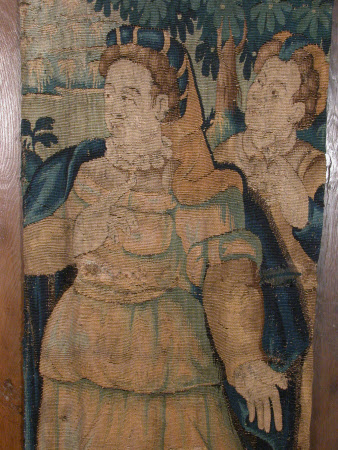Two Women (fragment)
Flemish
Category
Tapestries
Date
circa 1580 - circa 1610
Materials
Tapestry, wool and silk, 4 warps per cm
Measurements
2070 x 540 mm
Order this imageCollection
Packwood House, Warwickshire
NT 557852
Summary
Tapestry fragment, wool and silk, 4 warps per cm, Two Women, probably Oudenaarde, c.1580-1610. A narrow vertical panel showing a woman wearing a blue headdress and a white and yellow dress, with a blue cloak resting lightly on her shoulders. She appears to be watching something outside the left hand edge of the tapestry, and another woman standing behind her looks in the same direction. The tapestry has obviously been cut down on both sides from a larger panel. An arm in a yellow sleeve on the left hand side belongs to a figure that has been cut off, as does a hand with a blue sleeve on the right. At the top and bottom there are sections of borders with fruit and flowers on a yellow ground.
Full description
This fragment must once have formed part of a larger tapestry, and a note in the archive at Packwood refers to another fragment from the same tapestry at Selly Manor in Birmingham. The piece at Selly Manor is identified as ‘Achilles Refusing to Fight’, and shows a bearded man running away from two women proffering a shield, sword and helmet. However, the two pieces are of different shapes and the design does not obviously join up. Stylistic differences also suggest that it is unlikely that these two fragments once formed part of the same tapestry. The coarse weave and simple design of this tapestry suggest that it was made in one of the smaller weaving centres of the southern Netherlands, possibly Oudenaarde. Other examples of Oudenaarde tapestries with scenes from the history of Troy include a ‘Fight between Achilles and Hector’ formerly in the Agnelli collection, Turin (de Meûter 1999, p. 143) and two tapestries bought by the City of Oudenaarde in 1999 and now in the Stedelijk museum, Stadhuis Oudenaarde. The fragment at Selly Manor was reportedly bought by Laurence Cadbury (1889-1982) from Oliver Baker in 1936 for £5, and we can guess that Baron Ash bought his piece from the same source at around the same date. The two tapestries have similar blue cotton linings and were probably relined either before Baker acquired them or while in his possession. Oliver Baker was an artist, historian and antique dealer. He shared with Baron Ash an interest in local history, publishing ‘In Shakespeare’s Warwickshire’ in 1939, and his name appears frequently in the visitors’ book for Packwood House. Laurence Cadbury's grandfather John Cadbury, founded a business selling tea, coffee and chocolate in Birmingham in 1842; after his death his sons Richard and George took over, and the firm became known as Cadbury Brothers. Selly Manor was a fourteenth-century manor house on the outskirts of Birmingham which George Cadbury saved from demolition, dismantling it beam by beam and relocating it to the model village of Bourneille which he created as an alcohol-free, chocolate-producing utopia in the 1890s. It is furnished with items collected by George's son, Laurence. (Helen Wyld, 2009; revised 2024)
Provenance
Probably bought by Graham Baron Ash from Oliver Baker, c. 1936; given by Baron Ash to the National Trust in 1941
Credit line
Packwood House, The Graham Baron Ash Collection (The National Trust)
Makers and roles
Flemish, workshop probably Oudenaarde, workshop
References
de Meûter et al., 1999: Ingrid de Meûter, Martine Vanwelden et al., Tapisseries d'Audenarde du XVle au XVllle Siècle, Tielt 1999, p. 143 De Meûter, 1998: Ingrid de Meûter, ‘Flemish Tapestries of the 16th and 17th Centuries in Great Britain and their Connection with Oudenaarde’, Bulletin de liaison du Centre International d’Étude des Textiles Anciens [CIETA], 75 (1998), pp. 97-109

